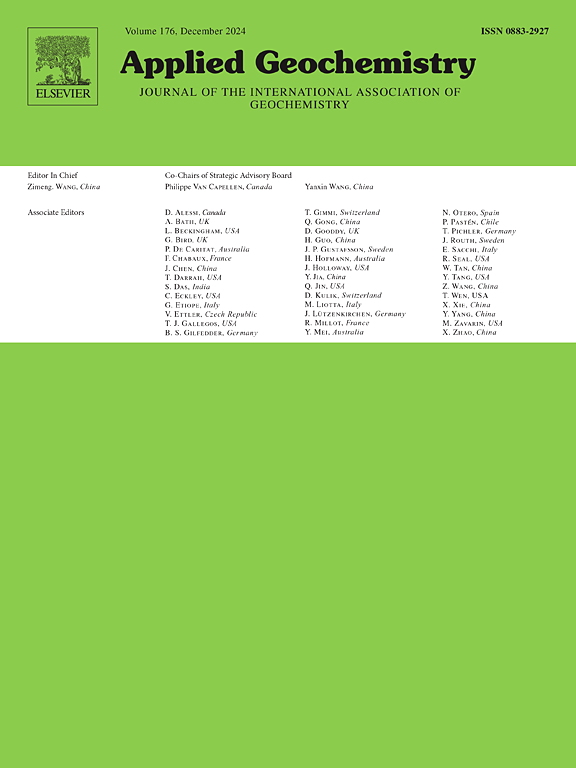Isotope geochemical study of the origin and formation mechanism of carbonate minerals in geothermal wells and surrounding hot spring waters in the western Unzen area
IF 3.4
3区 地球科学
Q1 GEOCHEMISTRY & GEOPHYSICS
引用次数: 0
Abstract
In areas of volcanic and geothermal activity, caprock and other impermeable layers regulate the flow direction of geothermal fluids. However, it is unclear how this impermeable layer was formed or at what depth. This impermeable layer is partly formed by carbonate minerals. In the Unzen area, the temperature logging results of geothermal wells showed that high temperature fluids move as lateral flow. In this study, we focused on the carbonate minerals in the area and determined the origin of the fluids from their isotope compositions. This study explores the formation mechanisms of carbonate layers through reactions between CO2-rich water and rocks within a volcanic geothermal system. Samples were collected from two geothermal wells and adjacent hot spring water in the western Unzen area for chemical and isotope analysis. The UZ-7 well, located near Mt. Unzen, features carbonate mineral layers at depths of approximately −300 m and −600 m. The isotope compositions of carbon and oxygen within these layers indicate a magmatic origin for the carbon, with the fluid mixture consisting of meteoric water, magmatic fluid, and fossil seawater. Deep fluids in the western Unzen region likely undergo vapor–brine separation at about −600 m elevation, where vapor escapes as fumarole gas and hot spring water in the Unzen hot spring area. The brine, approximately 240 °C, then flows westward, emerging at Obama hot spring. This lateral movement and heating of surrounding strata to about 150 °C at depths of −300 m and −600 m facilitate extensive calcite precipitation (up to 100 m thick) through rock interactions nearing chemical equilibrium. This process also results in significant kaolinite and chlorite deposition, potentially forming two impermeable caprock layers. The UZ-4 well, situated 2 km west of UZ-7, also exhibits carbonate layers, albeit on a reduced scale, likely due to insufficient rock reactions from progressively cooler brine temperatures.
云仙西部地区地热井及周围温泉中碳酸盐矿物成因及形成机制的同位素地球化学研究
在火山和地热活动区,盖层和其他不透水层调节地热流体的流动方向。然而,目前还不清楚这个不透水层是如何形成的,也不清楚它的深度是多少。这个不透水层部分是由碳酸盐矿物形成的。云仙地区地热井温度测井结果表明,高温流体以横向流动的方式运动。本研究以该区碳酸盐矿物为研究对象,通过其同位素组成确定流体的来源。本研究通过火山地热系统中富含二氧化碳的水与岩石之间的反应,探讨了碳酸盐层的形成机制。对云禅西部地区2口地热井及邻近的温泉水进行了化学和同位素分析。UZ-7井位于Unzen山附近,井深约为- 300米至- 600米,具有碳酸盐矿物层。这些层内碳和氧的同位素组成表明碳的岩浆起源,流体混合物由大气水、岩浆流体和化石海水组成。云仙地区西部深层流体可能在海拔- 600 m左右发生气卤分离,蒸汽在云仙温泉区以喷气孔气体和温泉水的形式逸出。大约240°C的盐水向西流动,出现在奥巴马温泉。在- 300米和- 600米深处,这种横向运动和周围地层加热到150°C左右,通过接近化学平衡的岩石相互作用,促进了方解石的广泛沉淀(厚达100米)。这一过程还导致大量高岭石和绿泥石沉积,可能形成两层不透水的盖层。UZ-4井位于UZ-7井以西2公里处,也发现了碳酸盐层,尽管规模较小,可能是由于逐渐降低的盐水温度导致岩石反应不足。
本文章由计算机程序翻译,如有差异,请以英文原文为准。
求助全文
约1分钟内获得全文
求助全文
来源期刊

Applied Geochemistry
地学-地球化学与地球物理
CiteScore
6.10
自引率
8.80%
发文量
272
审稿时长
65 days
期刊介绍:
Applied Geochemistry is an international journal devoted to publication of original research papers, rapid research communications and selected review papers in geochemistry and urban geochemistry which have some practical application to an aspect of human endeavour, such as the preservation of the environment, health, waste disposal and the search for resources. Papers on applications of inorganic, organic and isotope geochemistry and geochemical processes are therefore welcome provided they meet the main criterion. Spatial and temporal monitoring case studies are only of interest to our international readership if they present new ideas of broad application.
Topics covered include: (1) Environmental geochemistry (including natural and anthropogenic aspects, and protection and remediation strategies); (2) Hydrogeochemistry (surface and groundwater); (3) Medical (urban) geochemistry; (4) The search for energy resources (in particular unconventional oil and gas or emerging metal resources); (5) Energy exploitation (in particular geothermal energy and CCS); (6) Upgrading of energy and mineral resources where there is a direct geochemical application; and (7) Waste disposal, including nuclear waste disposal.
 求助内容:
求助内容: 应助结果提醒方式:
应助结果提醒方式:


